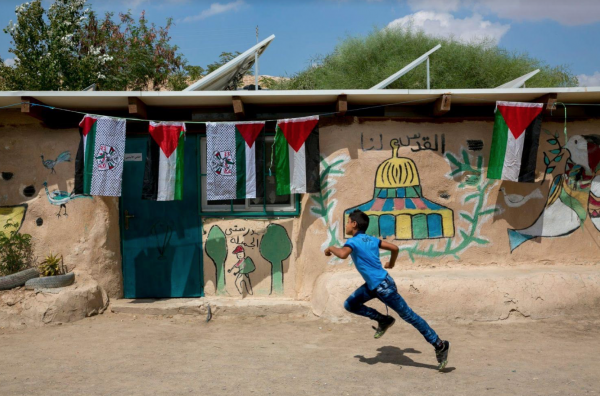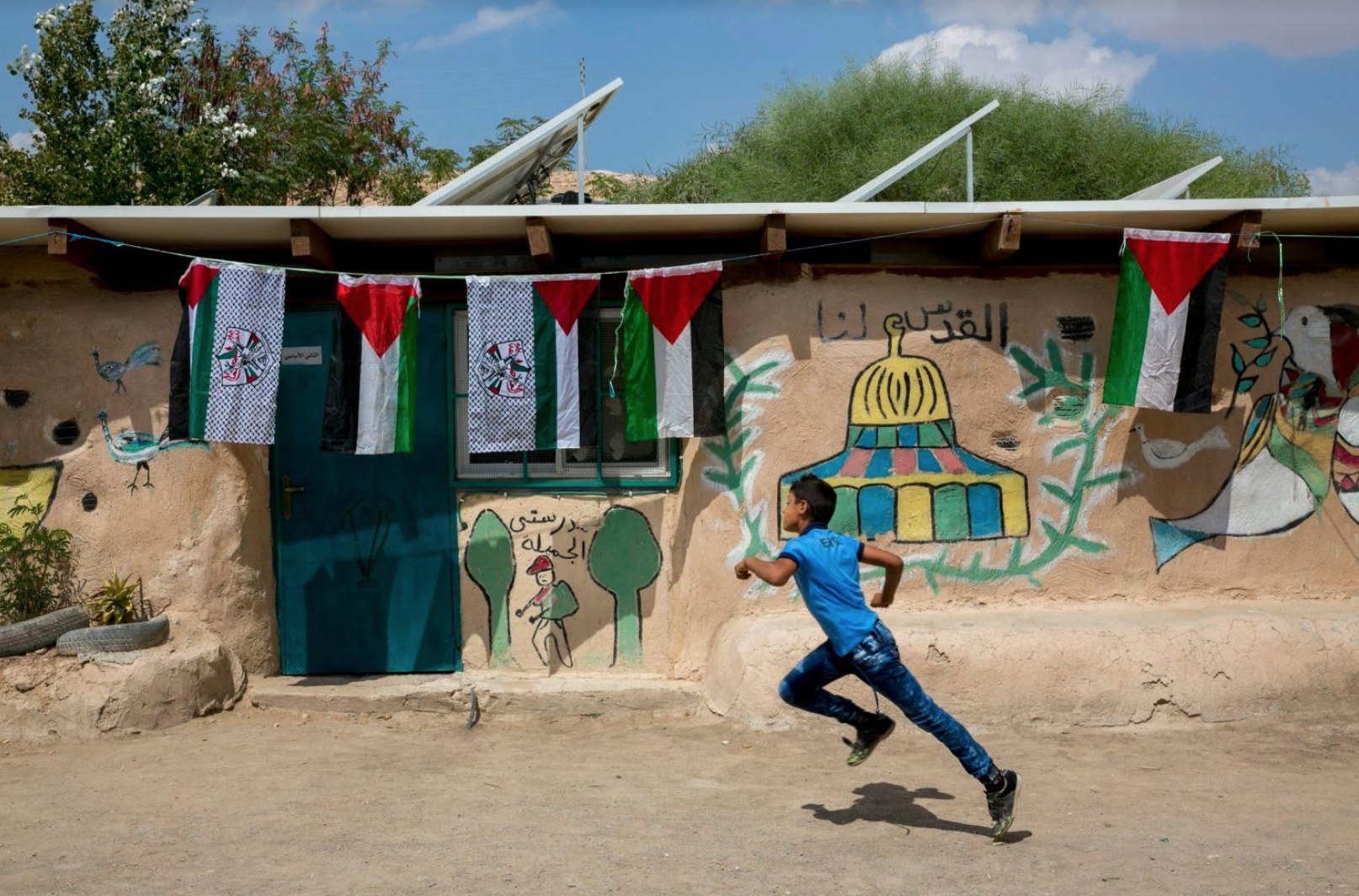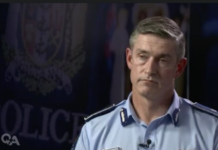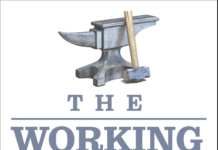
If, when travelling on the busy modern divided four-lane highway running down the steep hill from Jerusalem, eastward, on your way to Jericho, you were to look out the window on either side , you’d be shocked by the poverty, and wonder , who are these people, why are they so poor, how can anyone live like this.
In November 2011, my husband Martin and I were fortunate to be taken on a tour organised by ICAHD (Israeli Committee Against House Demolitions), to meet the Jahalin Bedouin people who live just off the highway. We learned their story, which really should be shared with the outside world.
As Itay Epshtain of ICAHD and Abu Khamis of the Jahalin people explained, this area isn’t their traditional home. In the early 1950s, they were forcibly transferred, ie ethnically cleansed, from their native Negev Desert where they had lived as semi-nomadic herdsmen. This was done as part of the Israeli campaign to ‘Judaize’ the Negev. They were moved to the Hebron hills where they were able to continue their pastoral livelihood and managed to make a living by supplying neighbouring villages with goat milk.
But after 1967, they were forcibly removed once more and dumped by the busy highway, left to subsist somehow as an ‘unrecognized village’, with no electricity, no water, no school, no clinic. The settlement, for Jews only, on a nearby overlooking hill, has water and power of course, and even a swimming pool.
Abu Khamis and his people were left so impoverished that these proud once self-sufficient people were forced to sell most of their animals, their livelihood, and now depend on UN charity to survive. The only hope for the Jahalin is that their children become educated. Maybe someday the Palestinians will become a free people or maybe someday Israel will become an inclusive society where all are offered opportunites to live with dignity.
But there was no school for the Jahalin. The only way children could get to a school was to cross the highway in front of them, dodging fast-moving traffic and then hail a taxi to take them to Jericho. The crossing was dangerous and the taxi expensive for such impoverished people.
After 4 children were killed and another 5 injured, the community leaders realised that somehow they would have to build a school themselves.
Fortunately they were aided by an Italian NGO, Vento di Terra, and some local NGOs including Pax Christi Jerusalem. Vento di Terra contacted another Italian aid group, Architettura Cooperazione, ARCo, who design and build low-cost eco-structures in remote poor areas.
ARCo accepted the challenge. They knew they would have to build structures that could be considered non-permanent, using unconventional materials. The Jahalin are located in Area C of the West Bank. That means the Israeli Army, calling itself the Civil Administration , are in control. Palestinians aren’t allowed to build with concrete and really aren’t allowed to build anything at all without a permit, which the Israelis do not grant to Palestinians. Palestinians are only too aware of their Kafka-esque situation.
ARCo were determined to create a low-cost eco-friendly school, using local labour. The plan they decided on, was to build the school using old tyres filled with sand to serve as bricks, and hold them in place with mud, sealed with used cooking oil.
In 2009 the Khan Al-Ahmar School opened. The PA (Palestinian Authority) provided teachers. At last, some 80 children could attend school safely. The Khan Al-Ahmar school was awarded a prize for its academic standards.
The school and the rest of the community were soon threatened with demolition orders. Israel wants to expand the huge settlement, for Jews only, of Ma’ale Adumim, just east of Jerusalem and remove all Palestinians in the way, effectively cutting the West Bank in two. The Israeli plan is to force the people to move once again, this time to a location very near the Jerusalem city rubbish dump.
Abu Khamis is well aware of the health risks of such a relocation. He wants his people to be allowed to return to their tribal territory in the Negev and is appealing to the nearly formed Bedouin Protection Committee for help. ICAHD is providing help to by taking the case to the UN, citing the International Covenant on Economic Social and Cultural Rights (ICESCR) and Article 53 of the Fourth Geneva Convention.
Martin and I visited the Jahalin again in 2012. Children proudly showed us their school. We were offered cups of tea as we listened to Abu Khamis sharing his concerns.
Visiting Palestinians is a life-changing experience. I’ve heard other people say that too. I often think of the children we’ve met over there, including the Jahalin children , when I see New Zealand children on their way to school or playing in the nearby park. We are so lucky to live in a country where it is taken for granted that every child will have easy access to good schooling.
That was our last visit. But we try to follow closely the story of the people, on their website jahalin.org. Others around the world are interested too, especially now as the Israeli Government has become even more arrogant and right-wing. In February 2014, a representative of the Italian consulate tried to deliver playground equipment donated by the Italian Government to the school. A drone flying overhead, watching the trucks arrive, notified the Civil Administration who came immediately and confiscated the equipment, saying that the school had no permit for playground equipment.
The most recent report is that Israel has renewed its intention to remove all Bedouin that are in the way of illegal settlements expanding. There is an agenda to ‘Judaize’ the Jordan Valley. The Italians who have been so helpful are disgusted that the school they designed and helped build, that they call La Sculo di Gomme (School of Tyres), could be demolished anytime. As the people of Vento di Terra say, “Chi Demolisce una Scuola Demolisce il Futuro” (Whoever demolishes a school demolishes the future).
By the time this article is published, maybe the school , and the hopes of the children for a future will have been destroyed. As long as Israel can do whatever it likes, with impunity, not just in Gaza, while the West looks the other way, there is not much hope for the indigenous people of the Holy Land.
This is where this article I wrote, in 2014, for a local, ie Christchurch, small Anglican magazine, ends.
But stories about Palestine never finish with a happy ending.
The Jahalin, helped by an Israeli attorney, tried to save their community by submitting
petitions to Israeli courts. The European Union has spoken in opposition to the removal of the Bedouin, saying such a step violates international law because it is forced displacement. The Jahalin hoped that international pressure would save them.
But on 24 May of this year, 2018, the Israeli Supreme Court granted the Civil Administration , meaning the Israeli military , permission to demolish the whole village: dwellings, school, sheep pens, toilets, warehouses, solar panels donated by Belgium , etc and forcibly move the entire clan to a small site near the largest rubbish dump in the West Bank.
The Civil Administration has already made plans to build around 90 houses with all services of course, for Jews only of course, after demolishing the village.
So there we are. Another facet of the oppression of the Palestinians, not in Gaza but in the West Bank this time. The story is not as dramatic as the outright massacres in Gaza but it is ugly. The Jahalin will be alloted a tiny plot of land for each extended family. The plot will be too small to keep animals, the traditional means of livelihood for Bedouin, a lifestyle in which women play an important role. There will be little or no employment available. Israeli journalist Amira Hass has visited the site and said it is infested with flies and rats from the garbage dump.
It’s a depressing story, especially depressing for me and Martin because we’ve been to the village, enjoyed their hospitality and listened to their stories.
If nothing else, we should support Donna Miles’ petiton to demand Superfund withdraw from Israeli banks that help expand Jewish only settlements in the West Bank. That would be a good start. But Israel’s impunity to cruelly oppress Palestinians must be challenged.
Lois Griffiths is a human rights activist






Thank you Lois; it is totally terrible that Palestinians may think that the rest of the world cares nothing for their tragic ongoing plight.
Unfortunately, as long as America indiscriminately supports modern Israel and Zionism, the outlook for a political solution remains bleak.
There is a slight glimmer of hope on the horizon.
Trump and co will destroy the American economy and funding to the Israel regime will have to be reduced or stopped.
Maybe
Alas no, Brigid, the US has just reduced its contribution to the UN agency for Palestinian refugees by more than 50%. I’m assuming that this is more bullying by the US to get support for it’s no longer supporting a two state solution, dunno.
Jared Kushner, Trump’s utterly vile peace-broker, is visiting those areas now, and part of the deal for tragic Palestinians is accepting a tiny Arab village, Abus Dis, as the capital of any future Palestinian state, instead of East Jerusalem.
Yep, we can only hope – and that hope’s much easier to live with than the grim day-to-day reality of being Palestinian.
The point I’m making, albeit facetiously, is that if the US financial support for Israel stopped, Israel may be forced to attend to decent governance of the country rather than brutalising Palestinians.
Yes Brigid, hope springs eternal…
He’s (Kushner’s) probably just visiting his investment properties there.
the petition is at
https://www.parliament.nz/mi/petitions/sign/PET_78417
Comments are closed.